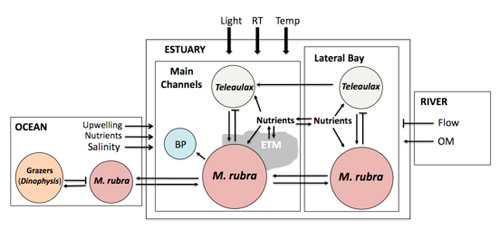You are here
Science Initiative II: Plankton Blooms
Goals
The Plankton Blooms science initiative aims to advance mechanistic understanding of (a) how red water species exploit the small-scale physics and nutritional environment to bloom in a large river-dominated estuary; (b) the molecular mechanisms behind bloom proliferation and controls on cryptic diversity within plankton blooms; and (c) the role of blooms in mitigating estuarine hypoxia.
- Uncover the source, genetic profile, and prey dependency of the bloom-forming ciliate.
- Identify the mechanisms of formation of Mesodinium rubrum (M. rubrum) blooms in the estuary.
- Characterize the influence of the blooms on the biogeochemistry of the estuarine bioreactor.
- Develop watches and predictors for the intensity and timing of bloom formation..
 Conceptual diagram of physical, biogeochemical and ecological factors governing M. rubrum bloom formation in the estuary (see text for details). A flat-headed arrow represents a negative impact (repression) and a pointed arrow represents a positive effect
Conceptual diagram of physical, biogeochemical and ecological factors governing M. rubrum bloom formation in the estuary (see text for details). A flat-headed arrow represents a negative impact (repression) and a pointed arrow represents a positive effect
The importance of plankton blooms
Phytoplankton are the base of nearly all marine food chains and have a significant impact on the global carbon cycle. In coastal upwelling systems, phytoplankton productivity is driven by nutrients delivered during upwelling events. In the northern California Current, phytoplankton blooms are predicted to increase in magnitude and duration as climate changes, and evidence from satellite ocean color suggests that increases in blooms are perhaps already occurring.
Although the Columbia River estuary (CRE) has significant allochthonous carbon inputs and has been characterized as a detritus-driven, net heterotrophic ecosystem], blooms of the ciliate Mesodinium rubrum occur each year in late summer in the lower estuary. From our earlier surveys, pelagic primary production appears to be dominated by this red water phenomenon, which consists of M. rubrum and an interconnected assortment of protists and bacteria. These blooms are notable for their persistence in a dynamic and rapidly flushed estuary; for the extremely fast swimming rates and vertical migration capabilities involved; and for the fascinating ecological relationship of the ciliate with the photosynthetic cryptophytes that act both as prey and as source of the functional plastids that M. rubrum utilizes for its own photosynthetic function.
The CRE physical environment oscillates between river dominance in winter and spring (up to the spring freshet which generally occurs in late May–June) to ocean dominated in late summer-early autumn. The transition from freshwater to ocean dominance coincides with M. rubrum blooms that generally occur well into the fall. Low flows, combined with vertical migration ability of the protist appear essential to permit retention and proliferation in the estuary. Autochthonous (lateral bay, estuary, ETM) and allochthonous (river and ocean) sources of nutrients ultimately fuel proliferation.
CMOP research has demonstrated that lateral bays are the source of the cryptophyte prey while the ocean harbors the M. rubrum population that ultimately enters the estuary. Further ecosystem linkages have been demonstrated by the enhanced bacterial production (BP) in the red water blooms and through the export to the plume where potential predators on M. rubrum may thrive, including the toxic dinoflagellate Dinophysis.
Science Initiative II Team
Initiative Leader
Peter Zuber, Oregon Health & Science University (OHSU)
Investigators
António Baptista (OHSU), Craig McNeil (APL-UW), Joe Needoba (OHSU), Tawnya Peterson (OHSU), Holly Simon (OHSU), Yvette Spitz (OSU)
Students, Post-Docs, and Staff
Rachel Golda (OHSU), Peter Kahn (OHSU), Michelle Maier (OHSU), Clara Llebot (OHSU), Sarah Riseman (OHSU), Mariya Smith (OHSU)
Operational Team Support
Astoria Field Team: Michael Wilkin (OHSU), Katie Rathmell (OHSU), Jo Goodman (OHSU)
Cyber Team: Charles Seaton (OHSU), Paul Turner (OHSU)
Clatsop Community College: Faculty and students of the Maritime Science Program and Integrated Technologies Program



